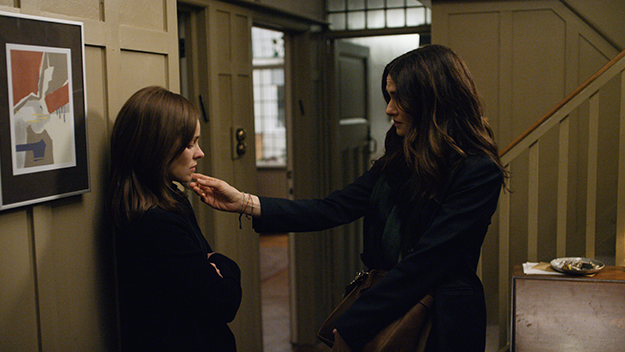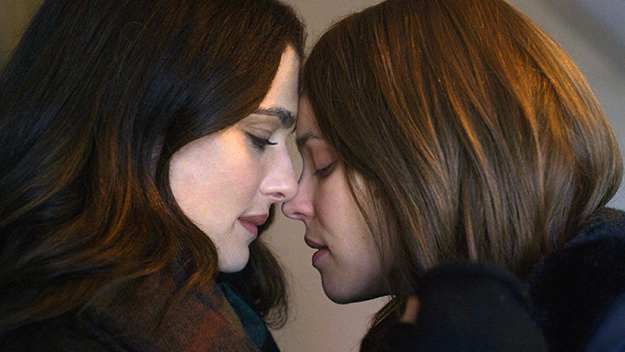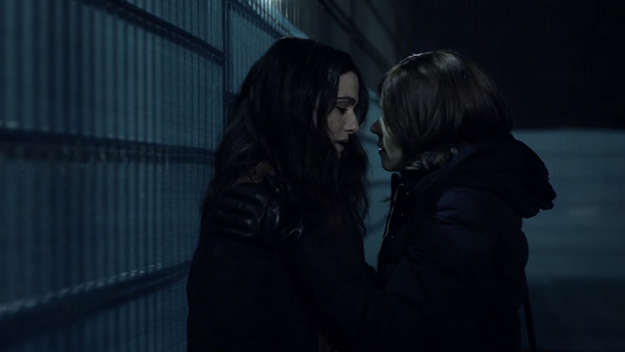Deep Focus: Disobedience

You can go home again—just for a visit. For me, that’s the most potent takeaway from writer-director Sebastian Lelio’s loose adaptation of Naomi Alderman’s 2006 novel, Disobedience. Rachel Weisz stars as a New York–based photographer named Ronit Krushka, who returns, after her Orthodox rabbi father’s death, to the Jewish London neighborhood where she grew up. She learns that her rabbi cousin Dovid Kuperman (Alessandro Nivola), the Rav’s designated successor, and her adolescent lover, Esti (Rachel McAdams), a schoolteacher, have become man and wife. Until Ronit broke from the community 11 or 12 years earlier, these three were bosom buddies. Ronit and Esti, though, were also passionate lovers. When they meet again, complications ensue.
Because of its central lesbian love scene, screening-room wits have dubbed this movie Jew Is the Warmest Color ever since its premiere at the Toronto International Film Festival last September. But Blue Is the Warmest Color turns out to be the wrong reference. True love between a worldly member of the culturati and a relative innocent, a specific Jewish backdrop, an acclaimed literary novel at the source—all these elements suggest a closer kinship between Disobedience and a more recent art-house hit about a gay romance. Think of it as Call Me by Your Hebrew Name.
There’s a reason this movie sets off joke titles in the skeptical part of our brains. It’s a way of letting some comic air into the picture’s hushed earnestness and single-mindedness, and its slight air of self-importance. Don’t get me wrong—Weisz and McAdams make a far more captivating and believable couple than Timothée Chalamet and Armie Hammer, and Lelio’s techniques, at least in the more casual scenes, express emotion instead of framing pretty pictures in the manner of Luca Guadagnino. The prospect of zeroing in on a forbidden relationship in a closed community piques our interest, and Lelio and his actors sustain it (the standouts include Anton Lesser in one virtuoso scene as the frail Rav Krushka). The film contains many felicitous touches and only one meretricious piece of melodrama: a sequence that misleads the audience into expecting a suicide.

Yet Disobedience is simpler than it looks. The roots of Ronit and Esti’s love lie in the past, and there are no flashbacks. Do they fall in love all over again? Not that I could tell. Visiting their old haunts—the Rav’s house where they played while he studied, the tree in the neighborhood green where they first kissed. They re-ignite their bygone passion. And as they ponder the consequences, each stays locked in her own head. When Ronit urges her to leave Dovid, Esti asks, desperately, “Where would I go?” Ronit leaves that sad question dangling. In the movie (unlike the book), these religious renegades don’t talk anything out.
The film tracks the offhand cruelties a strict enclave can inflict on anyone who leaves the fold or breaks its codes. The Rav’s congregants can’t forgive Ronit for not having come to the bedside of her ailing dad (though no one told her he was sick), and they worry that she’ll disrupt the memorial service designed to elevate Dovid. Even when she tucks her luxuriant dark hair under a sheitel, Uncle Hartog (Allan Corduner) takes it as a spiteful joke. (Joke, yes; spiteful, no.) People like him can’t accept that the Rav’s only child has embraced a secular life.
In the movie’s look and feel, the Chilean director Lelio treats Orthodox Jews with respect and some admiration. But the script focuses too intently on their small-minded reactions to an outsider’s return and her taboo behavior. (Lelio collaborated on the screenplay with Rebecca Lenkiewicz, who co-wrote Ida; her talent for terseness served her better in that brilliantly austere movie.) The commitment the ensemble brings to prayer at the Kupermans’ house or the gusto in the clerics’ singing “If I forget thee, O Jerusalem,” make the shunning of Ronit and the censure of Esti register more sadistically.

If you haven’t read the novel, the love story sneaks up on you, and not in a good way. It takes 45 minutes for the big “reveal.” Up to then, you might think that Ronit and Esti can’t get in synch because Ronit’s pals kept their marriage a secret from her. Commenting on the lovers’ physical connection, Weisz told Maureen Dowd in The New York Times, “I think, particularly for Esti, the release of this big orgasm that she had was also a spiritual moment. It’s about freedom.” But in the playing, it doesn’t come off as free or particularly spiritual. It feels like two brave actors giving each other an erotic workout and struggling to make their coitus distinctive, with details like Ronit tenderly spitting into Esti’s mouth. Weisz says that Lelio storyboarded every move. I believe it. Esti’s moaning ecstasy feels obligatory. It contrasts too glaringly with the joyless grunts she emits during her scheduled, robotic sex with Dovid.
Lelio must have wanted Ronit and Esti’s intimacy to carry the existential impact of the lovemaking in Blue Is the Warmest Color, without inviting the criticism of the “male gaze” that got pinned on its director, Abdellatif Kechiche. If “the male gaze” is responsible for the spontaneous, unpredictable lesbian lovemaking in Warmest Color, I must say, I’m all for it. Here’s what I do treasure about Disobedience: the lovers rediscovering their shared humor as they amble through Esti’s neighborhood, tugging the wheeled carry-on bag that has become the preferred tote for frum housewives. (“Frum” means devout.) Esti elucidating Othello, and its fateful handkerchief dyed in “maidens’ blood,” to a class of engaged schoolgirls. Dovid analyzing what he sees as the “higher” qualities of the sensuous Song of Songs, emphasizing, “my love is fair,”—with a table of equally enthusiastic rabbinical students. And Corduner’s Uncle Hartog guiding Friday night dinner with beaming patriarchal confidence, until Ronit explodes at guests who question her unmarried womanhood.
Lelio and his cinematographer, Danny Cohen, exploit Weisz’s dramatic features to the max: everything between the firm set of her chin and the sharpness of her cheekbones to her taut, wide brow exudes either grief or aggression. They also light and frame McAdams so observantly that we register each hint of psychosexual awareness in a twinkle of her eyes or a bend of her mouth. McAdams effortlessly and stunningly conveys Esti’s dizzying ripples of satisfaction or frustration with an orderly life. And Nivola, indelibly poignant as the doomed Mark Madoff in Barry Levinson’s HBO movie The Wizard of Lies, brings simmering warmth and low-key strength to the complicated role of a serious man who can’t accept the role of nice Orthodox Jewish prince. In one of the film’s most exquisite physical moments, he molds his hands around Ronit’s face to mime a comforting caress, since he can’t actually touch her.

Lelio has shaped the narrative line and the character arcs to his leading ladies’ known strengths. But too often he resorts to clichés. They come at the beginning, as Ronit struggles to surmount her grief with anonymous sex, and they keep coming at the end, when she finally achieves “closure” by snapping a picture of the Rav’s grave.
Staying true to the original text would have required a greater stretch. In Alderman’s book, Ronit is a go-getting, voluble, wisecracking financial analyst in the corporate sector, not a moody bohemian artiste. She can’t shake vestiges of Orthodox Jewish pride. She loves that she’s the only one in her work group who can name The Ten Commandments. Across the pond, Esti has clung to tradition partly to preserve her sanity. She must focus so urgently on each religious or tribal rite that she often goes silent. Her peers consider her odd and out of it. Even sweet-natured Dovid, insecure in his status as heir to the Rav, is prone to blinding headaches that bring on synesthesia. The pain registers in different colors—sometimes yellow, sometimes purple, sometimes like “a thin blue fog.”
Alternating with Ronit’s swingin’ first-person storytelling, an omniscient narrator leaps in and out of the characters’ heads, and each chapter begins with a mini-sermon based on Torah, Mishnah, the prayerbook, or hand-me-down sayings. We come to recognize Alderman in all three ruling voices, which are in turn funny, compassionate, and devastating. They help the author balance her paradoxes and contradictions. As she said in a publisher Q&A, “I prefer the grainy-textured, gamey, too-rich-for-some Orthodoxy to the homogenized, pasteurized version. Having said that, parts of Orthodoxy make me so angry I could scream.” Alderman doesn’t resolve the conflicts in her book. She does get them out and mess with them for one last time.
The film is well-groomed and self-contained and limited. It leaves you not with a howl, but with a piercing cri de coeur that fades away a little too soon.
Michael Sragow is a contributing editor to Film Comment and writes its Deep Focus column. He is a member of the National Society of Film Critics and the Los Angeles Film Critics Association, and a contributor to the Criterion Collection.







